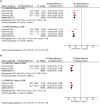Efficacy and safety of Resmetirom, a selective thyroid hormone receptor-β agonist, in the treatment of metabolic dysfunction-associated steatotic liver disease (MASLD): a systematic review and meta-analysis
- PMID: 39187533
- PMCID: PMC11347689
- DOI: 10.1038/s41598-024-70242-8
Efficacy and safety of Resmetirom, a selective thyroid hormone receptor-β agonist, in the treatment of metabolic dysfunction-associated steatotic liver disease (MASLD): a systematic review and meta-analysis
Abstract
Metabolic dysfunction-associated steatotic liver disease (MASLD) is an important public health problem owing to its high prevalence and associated morbidity and mortality secondary to progressive liver disease and cardiovascular events. Resmetirom, a selective thyroid hormone receptor-β agonist has been developed as a therapeutic modality for MASLD. This systematic review and meta-analysis aimed to evaluate the effectiveness and safety of resmetirom compared to a placebo in the treatment of MASLD. Eligible studies were systematically identified by screening PubMed, Scopus, Web of Science, Cochrane library, Embase, and ClinicalTrials.gov from 2014 to 2024. Only randomized controlled trials comparing the efficacy and safety of resmetirom in the treatment of MASLD against placebo were included in the analysis. Meta-analysis was performed using RevMan 5.4 software. Four studies with low risk of bias and involving a total of 2359 participants were identified. The metanalysis included only three clinical trials with 2234 participants. A significant reduction in MRI-proton density fat fraction (MRI-PDFF) with 80 mg Resmetirom compared to that with placebo [SMD - 27.74 (95% CI - 32.05 to - 32.42), p < 0.00001] at 36-52 weeks as well as at 12-16 weeks [SMD - 30.92 (95% CI - 36.44 to - 25.40), p < 0.00001]. With Resmetirom 100 mg dose at 36-52 weeks [SMD - 36.05 (95% CI - 40.67 to - 31.43), p < 0.00001] and 12-16 weeks [SMD - 36.89 (95% CI - 40.73 to - 33.05), p < 0.00001] were observed. Resmetirom treatment was associated with a significant reduction in LDL-c triglyceride, lipoproteins. and liver enzymes. There was significant reduction FT4 and increase in SHBG and sex steroids with Resmetirom compared to placebo. There was no major difference in the overall treatment emergent adverse events at 80 mg [OR 1.55 (95% CI 0.84 to 2.87), and 100 mg [OR 1.13 (95% CI 0.78 to 1.63), doses of Resmetirom compared to placebo. However, gastrointestinal adverse events diarrhoea and nausea occurred in ≥ 10% in the Resmetirom group compared to placebo at < 12 week. Resmetirom treatment showed modest efficacy in treating MASLD with reduction in MRI-PDFF, LDL-c, triglyceride, lipoproteins, liver enzymes and NASH biomarkers without significant safety concerns. Larger and long-term RCTs may further confirm this promising outcomes of Resmetirom use in MASLD.
Keywords: Metabolic dysfunction-associated steatotic liver disease; Non-alcoholic fatty liver disease; Non-alcoholic steatohepatitis; Resmetirom; Thyroid hormone receptor-β agonist.
© 2024. The Author(s).
Conflict of interest statement
The authors declare no competing interests.
Figures






References
Publication types
MeSH terms
Substances
LinkOut - more resources
Full Text Sources
Miscellaneous

